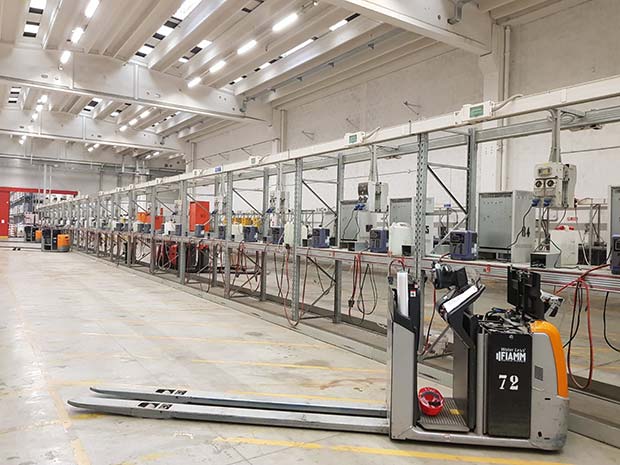Martin Walsh, Senior Product Manager Motive and Reserve Power at EnerSys EMEA, discusses 12 tips to help you efficiently charge even the largest of motive power batteries.

Warehouse operators are under continuous pressure to handle stock more quickly, and maximise power efficiency while doing so. One reflection of this is a growing trend to replace heavy duty internal combustion engine fork lift trucks with electrically-powered types. These larger electric trucks need larger batteries, together with chargers capable of charging them efficiently, quickly and reliably.
These challenges can now be met using High Frequency (HF) technology modular chargers. Capable of supporting 96V and 120V operations, and ratings to 21kW, they allow charging of the largest electric materials handling vehicles. Below is a list of 12 key issues that such chargers must overcome to improve productivity and power efficiency for users operating trucks of all sizes.
1: Supporting larger-sized materials handling vehicles
Challenge: Until now, a solution for charging 120V batteries at 21kW has not been available on the market from a large industrial charger manufacturer; the legislative and technology barriers have been too high.
Solution: Modular chargers with the correct HF technology can now overcome these barriers. This means that owners can support vehicles of all sizes with a single charger range. Additionally, the chargers’ modular design adapts to a wide range of battery capacities, allowing a potential reduction in the number of chargers on site; freeing-up valuable space while improving charging flexibility.
2: Maximising power efficiency
Challenge: As warehouse operations intensify, use largercapacity vehicles and consume more power, improving power efficiency has become essential.
Solution: Because of their highfrequency design and modular topology, modular chargers can achieve OPEX savings over the traditional ‘50Hz’ charger types. This can be further improved through the use of modern batteries with more advanced technology and lower input impedance.
3: Maintaining power efficiency throughout the entire charging cycle
Challenge: As a battery approaches full charge, its load on the charger reduces; this causes traditional chargers to operate less efficiently.
Solution: Modular chargers can have up to six modules sharing the load. These are progressively switched off as the load falls, so the modules remaining on line stay wellloaded and efficient throughout the entire charging cycle.
4: Energy wastage and reduction in battery life through overcharging
Challenge: Conventional chargers tend to overcharge their connected batteries by up to 20%; this wastes energy and can reduce battery life.
Solution: Using modular chargers with carefully designed charging profiles eliminates this tendency and prolongs battery life.
5: Keeping track of energy savings potential
Challenge: Modern, modular battery chargers are known to offer energy-saving benefits – but what is actually possible?
Solution: For example, internal tests have shown that, depending on locally prevailing energy costs, a 120V 1500Ah battery that would typically cost €50 to charge using a ‘50Hz’ charger would cost approximately €37 with the modular charger type. This represents significant possible savings when multiplied over the entire battery fleet’s daily operations.
6: Achieving high reliability
Challenge: As warehouses face ever-increasing pressure to move stock fast, they cannot afford to lose productivity through an inoperable charger.
Solution: Modular chargers share the load across their multiple modules. If one fails, the others continue to support the load at reduced power without stopping the charging process. For particularly critical operations, extra modules can be added for N+n redundancy.
Don’t miss part two of EnerSys EMEA’s 12 tips to help you efficiently charge even the largest of motive power batteries, in the June 15th issue of Warehouse & Logistics News.
ENERSYS




Comments are closed.